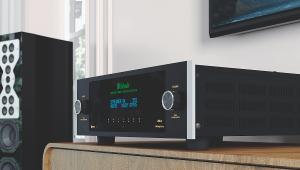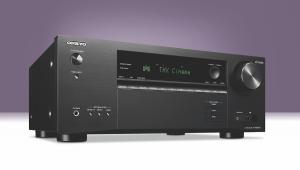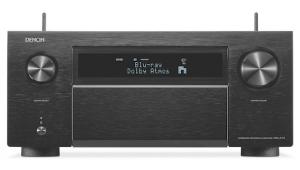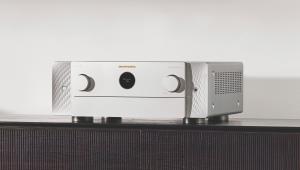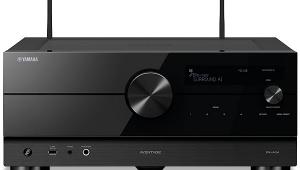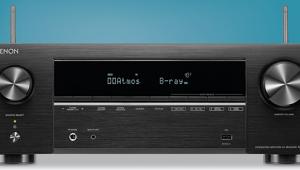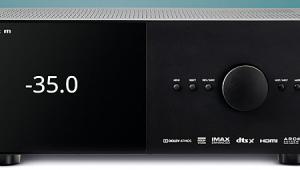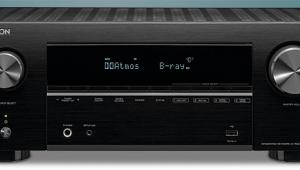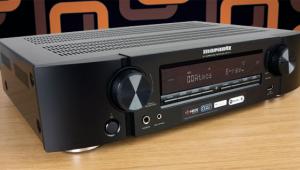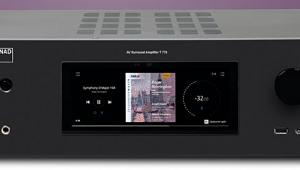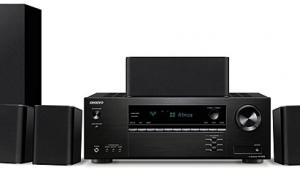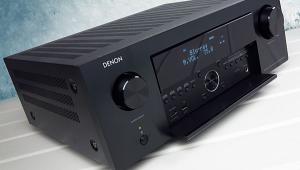Pioneer VSX-924 review
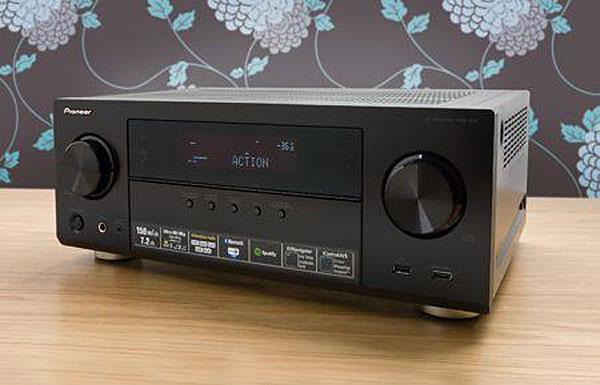
 Anyone enjoying a game of 'spot the difference between two AV receivers' would face a stiff task if faced with Pioneer's new VSX-924 and its predecessor, the VSX-923. This £500 home cinema power-pusher sports the same neat styling and shares many of the same specifications. But dig a little deeper and you'll find some key upgrades that see Pioneer embracing new trends in AV.
Anyone enjoying a game of 'spot the difference between two AV receivers' would face a stiff task if faced with Pioneer's new VSX-924 and its predecessor, the VSX-923. This £500 home cinema power-pusher sports the same neat styling and shares many of the same specifications. But dig a little deeper and you'll find some key upgrades that see Pioneer embracing new trends in AV.
Chief amongst these, perhaps, is the employment of HDMI 2.0 connectivity. Pioneer claims the VSX-924 will pass full 4K/60p with 4:4:4 colour sampling, allowing it to potentially form part of a next-gen setup. However, it doesn't support HDCP 2.2, the latest copy protection standard which could conceivably form part of a 4K BD standard, although Philippe Coppens, Pioneer Europe's product manager, says that any future HDCP 2.2 sources are likely to have dual outputs so the AVR can be bypassed...
Okay, so maybe it's not as future-proof as you might like, but Pioneer has endowed the VSX-924 with other state-of-the-art features. An apt-X Bluetooth receiver is now built-in, doing away with the frustrating buy-a-£50 adaptor strategy of last year. Wi-Fi is still via adaptor, but this is bundled free in the box. Pioneer doesn't like to build it directly into the chassis for 'performance reasons', I'm told.
Beneath the hood there have been tweaks, too. The AKM DAC has been replaced by an ESS Sabre Premier ES9006S, the same you'll find in some £1,500 receivers, while custom capacitors have been fettled to massage audio. The MCACC system suite now includes subwoofer EQ in addition to the usual parameters, and tuning has been completed by Pioneer's LX team, who normally don't dirty themselves at this price point.
On the software side, Spotify Connect is present from launch (I'd prefer Rdio, personally, but that's just me) and file compatibility now extends to multichannel 24-bit/96kHz FLAC and WAV, plus DSD over a network as well as USB. The AV Navigator interactive manual is now 'built-in' too – plop the Pioneer on your home network and you can call it up on your phone/tablet/laptop.
MHL mysteryConnectivity is rather good, considering the price point. HDMI runs to seven inputs and two outputs. One of the inputs is mounted on the front, although oddly this is no longer the MHL option (it's now on the rear). Then there are two USB ports (one front-mounted), coaxial and optical digital audio inputs, and the usual analogue tomfoolery.
Speaker binding posts feel fairly robust. In fact, so does the receiver itself – it's not going to challenge the likes of Primare's SPA23 in the luxury construction stakes, but buyers won't feel short-changed. The styling, as previously noted, is near identical to its 2013 forebear. If you like things chunky, black and symmetrical, you've come to the right place.
In use it's not the smoothest device. The combination of lengthy feature list, utilitarian menus and button-tastic remote can lead to moments of frustration. The slim, lightweight handset has been reconfigured, but still offers tiny keys, many with dual functions and confusing nomenclature. I quickly moved to the dedicated app. Pioneer is now up to iControlAV5, backwards-compatible to 2012 hardware, and it's absolutely stunning, even on a smartphone rather than a tablet. A feast of natty graphics and interactive controls, it strives to explain what many of the VSX-924's features do. From here, experimenting with tools like the Auto Sound Retriever or Phase Control becomes easy.
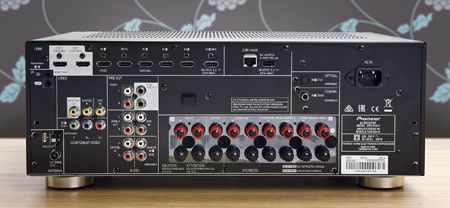 Outer-space operatics
Outer-space operatics
I was a big fan of the audio performance of the VSX-923 and this successor continues the good work. Once again, multichannel film soundtracks benefit from a sound that is clear, focused and adept at eking out detail.
With Gravity on Blu-ray, the Pioneer approaches its DTS-HD MA 5.1 mix with cool, calculated poise. Audio pans are guided with stellar precision, so that when Sandra Bullock's unfortunate astronaut is sent spinning into space in the opening act, the mixture of Foley effects, panicked screams, and electro score slip and slide around the soundfield. Combined with my Monitor Audio MASS 5.1 array, the result is delightfully cinematic. All of this occurs with the amp's MCACC Room EQ system in use. Getting it set up involves the usual beepy-noise banter, and once complete it certainly made good strides in my room, improving the overall balance and cohesion of the front soundstage in particular. You can manually tweak its settings, or switch it off, if you prefer.
With the shootout at the close of Prohibition Era drama Lawless (BD), the VSX-924 brings dynamic attack to the gunshots and ricochets. Foley effects are crisply delivered, again with pin-point accuracy, and low-frequency impacts impress. The AVR remains in utter control.
Don't mistake the VSX-924's deft handling for a conservative nature, though: it offers impressive punch for its price from its claimed 7 x 150W (into six ohm) power plant and relishes up-tempo music material. Clubland hit #Selfie by The Chainsmokers, streamed via Bluetooth (MP3), pumps out of my array with foot-tapping vigour. Indeed, the Pioneer's Bluetooth integration means it's so easy to enjoy your digital library in surround sound that you'll wonder why you bought that budget wireless speaker at Christmas.
FLAC, WAV, M4A and MP3 files all happily played out from my network and USB. As did DSD 64 material, but not higher-spec DSD 128 files. Britten's Simple Symphony Op 4, downloaded from www.2L.no in the former, showed the VSX-924 comfortable with the change of pace and increase in fidelity, conveying the layered nature of this string piece and good instrument separation. Of course, audiophiles will find it lacks in terms of sheer smoothness and fluidity, and there's a sense that it's digging hard into its reserves rather than coasting along unflustered, but this is, after all, a budget proposition.
Useful upgradesIndicative of the rather slow-moving nature of the entry-level/mid-range AVR market, the VSX-924 arrives offering useful upgrades rather than a brand-new approach. Beyond, perhaps, its HDMI 2.0 spec and Wi-Fi/Bluetooth chops, it doesn't present any urgent reason to replace another £500 receiver from the last couple of years, should you have one. And those with bigger budgets and serious setups will pass it by, especially if they have an eye on Dolby Atmos, which the Pionner can't handle.
Still the VSX-924 caters admirably for the home cinema separates newbie. The VSX-924 is another well-judged AVR from a brand that certainly knows its audio onions. Packed with features, and great value for money, just add a 5.1 array and you can sample authentic cinema sound.
Specification
Dolby TrueHD: Yes. And Dolby Pro-Logic IIz
DTS-HD Master Audio: Yes. And DTS Neo:X
THX: No
Multichannel input: No
Multichannel output (claimed): 7 x 150W (6 ohms)
Multiroom: Yes. Zone 2 AV
AV inputs: 2 x composite; 2 x digital audio (1 x optical and 1 x coaxial)
HDMI: Yes. 7 x inputs; 2 x outputs (v2.0)
Video upscaling: Yes. To 4K
Component video: Yes. 1 x input
Dimensions: 435(w) x 362(d) x 168(h)mm
Weight: 9.8kg
Also featuring: Direct Energy Amplifier; MCACC Room EQ with subwoofer EQ; music streaming via network/USB includes WAV (96kHz/24-bit, 5.1), FLAC (96kHz/24-bit, 5.1), AIFF (96kHz/24-bit), MP3, ALAC, DSD; Spotify Connect; Apple AirPlay; Bluetooth; Wi-Fi (via free adaptor); 2 x USB; Ethernet; 2 x subwoofer preouts; 9 x speaker terminals; vTuner net radio; AM/FM radio; AV Navigator software; control via iControlAV5 app; Auto Sound Retriever; Auto Level Control; Phase Control; Virtual Speakers
 |
Home Cinema Choice #351 is on sale now, featuring: Samsung S95D flagship OLED TV; Ascendo loudspeakers; Pioneer VSA-LX805 AV receiver; UST projector roundup; 2024’s summer movies; Conan 4K; and more
|





